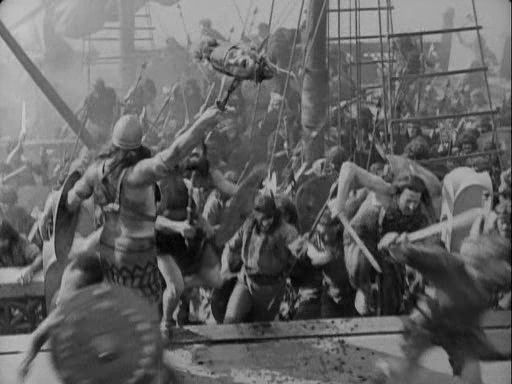
One of the most cohesive fantasy epic films I've ever seen, 1959's Ben-Hur, is a beautiful spectacle with engaging character development. It's the combination of the vision of a talented director, William Wyler, with daring and budget. It's an enormously impressive film.
Ben-Hur was originally a novel, published in 1880, but the 1959 film is a remake of the 1925 film, based on the novel, carrying over several stylistic choices from the earlier film. The story follows Judah Ben-Hur, here played with wiry vulnerability by Charlton Heston. Ben-Hur is a wealthy Jewish prince in Roman occupied Jerusalem and as the film begins, Judah welcomes home Messala, a childhood friend who returns after years' absence that have transformed him into a tribune. The Roman culture that prizes conquest and social hierarchy has also made Messala into a man who considers the Jews to be an inferior race, meant for subjugation to Rome.

The first point in which Wyler's Ben-Hur improves on the 1925 film is in Judah's and Messala's relationship. It was broad and sort of perfunctorily established in the older film, the two meeting as friends before Messala turns into a snarling beast in Judah's home. Here, the pain both men experience as their love for each other conflicts with their principles as adults is credibly established in dialogue between the two actors and motivates the bitterness between the two throughout the film.

When Messala has the Ben-Hur family arrested on flimsy pretexts, it doesn't seem like quite the arbitrary shift it does in the 1925 film. Here we can see in Stephen Boyd's performance as Messala the painful internal conflict that forces such heavy action. As in the 1925 film, Judah is sent to the galleys while his mother and sister are placed deep in a subterranean dungeon.

Judah's sister Tirzah is played by Cathy O'Donnell, an actress who won my adoration for possessing a quality of intellectual raw nerve in They Live by Night, a noir from eleven years earlier. Sadly, her role in Ben-Hur came near the end of a rather short career. She married William Wyler's brother on my birthday, April 11, in 1948 and she also died on my birthday, in 1970, at the age of 46. I was really responding to her even before I found this out.
Anyway, her role is sadly tiny in Ben-Hur.

The sea battle sequence is one of the places where the 1925 film is superior. The sequence is great in the 1959 film, with some well shot, very realistic models and the grinding, day to day point of view of a galley slave is nicely established. But the 1925 film, in its greater use of actual ships on which were packed thousands of extras who then fought one another in a frenzy, is simply a more breathtaking vision of chaos on a grand scale.

The 1959 film also suffers by comparison from its lack of topless women in the parade scenes, but the scenes in Rome, where Judah buddies up with prominent Romans, are quite impressive.

In light of these scenes, I don't know if Judah's turning against Rome later is quite believable.
Of course, the most famous scene from both film versions of Ben-Hur is the chariot race.

Here I would have to say it's very difficult to compare the films. The scenes are actually very similar, though the older film relied entirely on enormous outdoor sets while the 1959 version expands a still impressively large set with matte paintings. Otherwise, the sets are remarkably similar. More importantly, the two versions of the scene have an extraordinary amount of palpable realism.

There's no rear projection--close-ups of the actors on the chariots appear to come from cameras mounted on the chariots while the actors actually drove the chariots.

The 1959 film features chariot drivers falling off their chariots and being trampled by the horses of their competitors. The Wikipedia entry says "lifelike dummies" were used, but if someone told me this was a cover story concocted by the studio to conceal that actual actors were trampled, I would not be surprised.

Even in good movies, dummies are usually pretty obvious. Here, I swear I saw these "dummies" moving--in any case, they had a remarkable ratio of rigidity and pliancy.

Certainly the 1925 film ought to have ended after the chariot race. The 1959 version does a slightly better job of making interesting the story of the Ben-Hur women as lepers and watching Christ getting crucified. But since at this point Judah's story about learning the value of not fighting for vengeance and status is pretty muddled by the fact that it was so great seeing him win the chariot race, it probably would've been as well to end it there. I would certainly dig a movie about how the nobler outlook on reality isn't one that sees it as a constant scrape for dominance, but it's not something I'd expect a Hollywood studio to invest millions of dollars in. Might as well enjoy the juvenile fantasy.


No comments:
Post a Comment